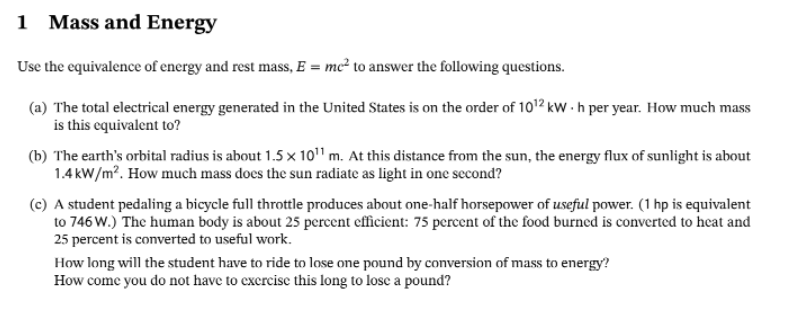1 Mass and Energy Use the equivalence of energy and rest mass, E = mc² to answer the following questions. (a) The total electrical energy generated in the United States is on the order of 10¹2 kWh per year. How much mass is this equivalent to? (b) The earth's orbital radius is about 1.5 × 10¹1 m. At this distance from the sun, the energy flux of sunlight is about 1.4 kW/m². How much mass does the sun radiate as light in one second? (c) A student pedaling a bicycle full throttle produces about one-half horsepower of useful power. (1 hp is equivalent to 746 W.) The human body is about 25 percent efficient: 75 percent of the food burned is converted to heat and 25 percent is converted to useful work. How long will the student have to ride to lose one pound by conversion of mass to energy? How come you do not have to exercise this long to lose a pound?
1 Mass and Energy Use the equivalence of energy and rest mass, E = mc² to answer the following questions. (a) The total electrical energy generated in the United States is on the order of 10¹2 kWh per year. How much mass is this equivalent to? (b) The earth's orbital radius is about 1.5 × 10¹1 m. At this distance from the sun, the energy flux of sunlight is about 1.4 kW/m². How much mass does the sun radiate as light in one second? (c) A student pedaling a bicycle full throttle produces about one-half horsepower of useful power. (1 hp is equivalent to 746 W.) The human body is about 25 percent efficient: 75 percent of the food burned is converted to heat and 25 percent is converted to useful work. How long will the student have to ride to lose one pound by conversion of mass to energy? How come you do not have to exercise this long to lose a pound?
University Physics Volume 3
17th Edition
ISBN:9781938168185
Author:William Moebs, Jeff Sanny
Publisher:William Moebs, Jeff Sanny
Chapter5: Relativity
Section: Chapter Questions
Problem 113AP: The sun energy at a rate of 3.85×10 26 W by the fusion of hydrogen. About 0.7% of each kilogram of...
Related questions
Question

Transcribed Image Text:1 Mass and Energy
Use the equivalence of energy and rest mass, E = mc² to answer the following questions.
(a) The total electrical energy generated in the United States is on the order of 10¹2 kWh per year. How much mass
is this equivalent to?
(b) The earth's orbital radius is about 1.5 x 10¹¹ m. At this distance from the sun, the energy flux of sunlight is about
1.4kW/m². How much mass does the sun radiate as light in one second?
(c) A student pedaling a bicycle full throttle produces about one-half horsepower of useful power. (1 hp is equivalent
to 746 W.) The human body is about 25 percent efficient: 75 percent of the food burned is converted to heat and
25 percent is converted to useful work.
How long will the student have to ride to lose one pound by conversion of mass to energy?
How come you do not have to exercise this long to lose a pound?
Expert Solution
This question has been solved!
Explore an expertly crafted, step-by-step solution for a thorough understanding of key concepts.
This is a popular solution!
Trending now
This is a popular solution!
Step by step
Solved in 3 steps with 3 images

Knowledge Booster
Learn more about
Need a deep-dive on the concept behind this application? Look no further. Learn more about this topic, physics and related others by exploring similar questions and additional content below.Recommended textbooks for you

University Physics Volume 3
Physics
ISBN:
9781938168185
Author:
William Moebs, Jeff Sanny
Publisher:
OpenStax

College Physics
Physics
ISBN:
9781938168000
Author:
Paul Peter Urone, Roger Hinrichs
Publisher:
OpenStax College


University Physics Volume 3
Physics
ISBN:
9781938168185
Author:
William Moebs, Jeff Sanny
Publisher:
OpenStax

College Physics
Physics
ISBN:
9781938168000
Author:
Paul Peter Urone, Roger Hinrichs
Publisher:
OpenStax College


Physics for Scientists and Engineers, Technology …
Physics
ISBN:
9781305116399
Author:
Raymond A. Serway, John W. Jewett
Publisher:
Cengage Learning

College Physics
Physics
ISBN:
9781285737027
Author:
Raymond A. Serway, Chris Vuille
Publisher:
Cengage Learning

College Physics
Physics
ISBN:
9781305952300
Author:
Raymond A. Serway, Chris Vuille
Publisher:
Cengage Learning